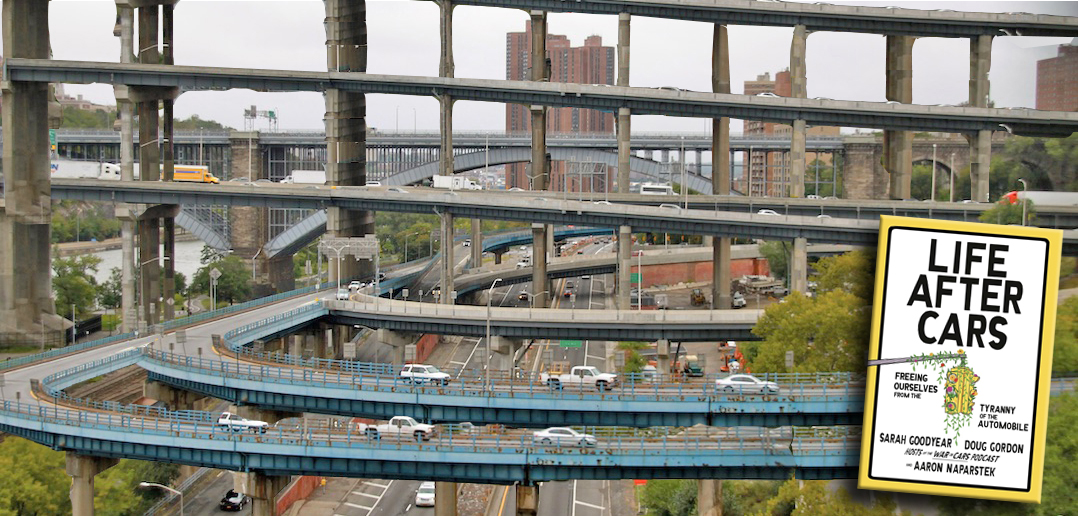What if we banned every single car from the streets of your city tomorrow?
That's not the question that Doug Gordon, Sarah Goodyear and Aaron Naparstek are asking in their first book, "Life After Cars: Freeing Ourselves From the Tyranny of the Automobile." As the creators of the wildly popular podcast the War On Cars, the three advocates have made a career of using provocative statements about transportation and the wild assumptions they conjure up — "cyclists and pedestrians hate automobiles and want to rip the SUV out of your garage!", for instance — to lure audiences into a more nuanced conversation about America's harmful and deeply auto-centric transportation culture.
Their first outing as authors, though, gives the three safe streets superstars space to push that exploration to a new frontier:

What would our world look like if cars weren't at its center? And how can we make sure everyone sees how it important it is that we do?
"Life After Cars" does more than just synthesize the mountain of insights that Gordon, Goodyear, and Naparstek have gathered over the years since their podcast launched in 2018, plus their collective decades of writing about and fighting for better cities. (Full disclosure: Naparstek founded Streetsblog in 2006, and both Goodyear and Gordon have written for us.) It's part alternate history of the automobile, part exploration of how car culture conditions us to accept other forms of violence — and most important, a call to action to build a better world.
Before they get to that better world, though, Gordon, Goodyear and Naparstek first unpack the broken one we already have. The bulk of the book's chapters are devoted to cataloging all the things cars "ruin" — childhood, nature, society itself — and the ways that mass motoring makes our communities more deadly and unjust.
For people who are new to conversation about automobility, these chapters will read like a shocking exposé of just how thoroughly car domination distorts our world, and it will change the way they see that world forever. For seasoned transportation reform advocates who have already had their minds similarly blown, though, it will still offer some surprises; I write five articles a week about this stuff, and even I had no idea how thoroughly our highway system has interrupted animal migration patterns, or the devastating impacts that has on national ecosystems, until I read this book.
"Life After Cars" is packed with stats and pearls from former guests that die-hard fans of the podcast will surely remember — authors like Peter Norton, Megan Kimble, and Streetsblog USA alum Angie Schmitt all make appearances — and the book is so rigorously researched that the endnotes run into the hundreds. But some of its best moments are stories from the authors' personal lives, like Goodyear's unexpected connection to the Goodyear tire empire (yes, there's a relation) and Gordon's heartwarming story of his daughter's fight for a bike corral outside her Brooklyn school.
In the run-up to this month's release of the book, experts have been hailing it's central thesis.
“The car may be the feature of modern life we take most for granted. But as this brilliant book makes clear, we should be asking deep questions about whether we want to keep shaping our communities and our lives around automobiles: We’re ready for the shake-up these authors inspire," said environmentalist Bill McKibben.
But what will make "Life After Cars" an enduring entry into the urbanist canon is how it challenges readers to connect our car dependent transportation system to the broader erosion of humane society, and to imagine a world where, as the authors movingly write, “we can choose a human shape” for our society, rather than continuing to allow cars to shape us into something increasingly unrecognizable. It's a message we need now more than ever, and an effective book that, hopefully someday, we won't need at all.
Or, take it from former New York City Department of Transportation Commissioner Janette Sadik-Khan:
“If the great American love affair with the automobile in the 20th century was really an arranged marriage, then 'Life After Cars' are the papers served for a conscious uncoupling," she said. "By fighting for what’s best for cites from the street to the schoolyard, the authors are ultimately fighting for what’s best for our people and the planet.”






